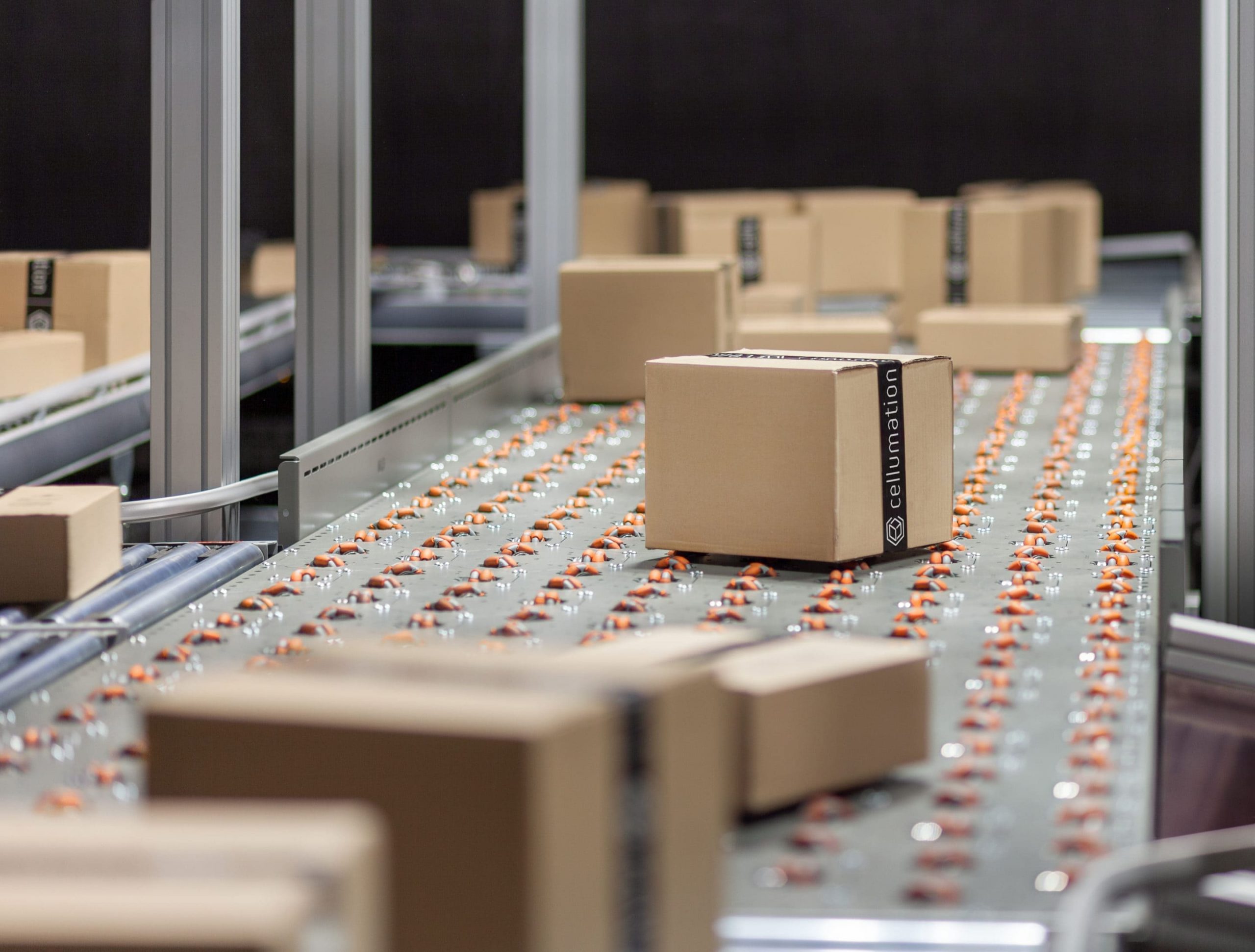Conveyor Technology 4.0:
Modular, flexible, intelligent
Efficient conveyor technology ensures a smooth material flow of conveyed goods. Even Henry Ford once said “If I had asked people what they wanted, they would have said: faster horses”. Our technology even goes one step further, digitizing and accelerating conveying processes.
The solution to these challenges is: Modular and software-driven conveyor technology, which is built around a single component: the cell.
Material flow in today’s logistics centers, warehouses, and manufacturing plants is largely based on inflexible roller conveyors. These are characterized by the fact that they can only carry out simple intralogistics tasks Specifically, moving objects in a straight line. For more complex tasks (e.g. rotating, separating, sorting, etc.), the conveyor technology must be extended by additional mechanical components. Quite often, even industrial robots have to be integrated in order to complete simple tasks. As a result, conveyor technology is rigid, inflexible, maintenance-unfriendly and cost-intensive. These are the core challenges for the conveyor technologies of the future.
Advantages of modular & software-driven conveyor technology
Flexible
Due to the celluveyor’s flexibility, logistics companies are able to adapt their technology to their processes, instead of the other way around.
Security of investment
Reusability in other applications offers a high level of investment security.
Compactness
Thanks to the cellular design in combination with its software-driven technology, the celluveyor can perform complex movements in a very small area.
Disadvantages of traditional technology
Inflexible
A change in logistics processes frequently requires a change in installation layout from the relocation of hundreds to thousands of meters of conveyor technology, to the integration of new components, to a complete redesign of the conveyor systems for the transport of goods.
Maintenance-unfriendly
The more complex the system, the more spare parts need to be stocked. Each technical maintenance must be reconsidered from the ground up. This can become time-consuming.
Space & cost intensive
Floor space, especially in the neighborhood of urban centers, is becoming more and more expensive. At the same time, the logistics volume is increasing, and accordingly more material has to be transported on the available space. We can observe how technology has made computer chips shrink more and more, but conveyor technology has not fundamentally changed. Existing systems make it difficult to save space while maintaining efficiency.
The modular conveyor technology: celluveyor
The celluveyor (short for: cellular conveyor) is an innovative conveying and positioning system that can be used in a wide range of applications within material flow systems. The concept is simple: the cells, which can perform complex material flow tasks through communication and cooperation, are the lowest common factor of this technology.
The hexagonal cells serve as the system’s core, with several individually driven omnidirectional wheels. The goods to be transported can be moved, oriented, and positioned independently of each other on any path due to the special arrangement of the wheels and the possibility of targeted control of the drives. Without much effort, the cells can be combined to form any system layout. As a result, almost all conveying tasks can be performed using a single basic hardware.
The design allows for easy maintenance while reducing the downtime of your system. If one cell fails, the six surrounding cells take over first. This is why we speak of sixfold redundancy. To replace a cell, even the inexperienced need only a screwdriver, unscrew seven screws and insert a new cell in under five minutes.
Cells and software work in symbiosis. They are like ying and yang. A selected software app specifies the functionality of the celluveyor system. Examples are: Layer Separation, Rotate & Sort. The software processes the information picked up by the vision system and converts it into action instructions for the cells. The same hardware constellation can switch between different software apps without any mechanical changes. Therefore, we speak of software-driven conveyor technology. The software monitors what is happening on the celluveyor, protects the transported goods and brings them gently to their destination. Contact between items is minimal, protecting them against product damage.
Unique throughput and material handling flexibility
The cellular approach and intelligent control offer users and system integrators flexibility. In addition to layout and process flexibility (functions can be adapted through software updates), the celluveyor enables unique throughput and material handling flexibility.
Throughput flexibility: If the system’s throughput needs to be adjusted (e.g.,g. due to growth or seasonality), this can be done continuously by adding or removing cells. Similarly, software optimizations (e.g., sorting algorithms and strategies) can increase throughput, which is highly relevant during peak periods.
Conveyor flexibility: The celluveyor can transport objects of any shape as long as the underside is almost flat, resulting in high conveyor flexibility of the transported goods. Load capacity can be ensured by stressing several wheels. The celluveyor can take on any parcel posted with a CEP service provider.
Not all conveyor technology is the same!
Comparing the celluveyor to existing technology is difficult. This is due to the fact that competing systems frequently require much more space for the same functionality and several modules connected in series. Each of these has a task to do, but not for every product that is transported. As a result of this, the size of the system grows.
We work with intelligent systems to perform multiple functions on multiple products in one area at the same time. This eliminates the need to string modules together, allowing you to make better use of your space and increase your throughput!
cv.DEPAL
cv.GO
Products
Nico Loibersbeck
Sales

We love our technology and love to talk about it. There are still questions open?
